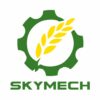In forestry management, the durability and efficiency of equipment like mulchers and wood grinders are crucial. A key strategy to extend the life and performance of these machines is through the use of wear-resistant overlays and carbide particle-enhanced overlays. This article explores the differences, suitable applications, and cost implications of these two types of overlays to help you make informed decisions.

Exploring Carbide Particle-Enhanced Overlays
Carbide particle-enhanced overlays incorporate hard particles like tungsten carbide into the base material (e.g., chromium carbide or boron carbide), significantly improving wear and impact resistance. These overlays are designed for harsh conditions where equipment faces both high wear and impact.
Benefits of Carbide Particle-Enhanced Overlays
Superior Wear Resistance: Provides excellent protection in extreme conditions.
High Impact Resistance: Ideal for applications involving heavy impacts and abrasive materials.
Extended Maintenance Intervals: Less frequent reapplication needed, reducing downtime.
Limitations of Carbide Particle-Enhanced Overlays
Higher Initial Cost: More expensive due to the inclusion of hard particles and complex application process.
Application Complexity: Requires specialized equipment and expertise for proper application.
About Carbide Particle Overlay
- Features: Carbide particle overlay is to melt Carbide particles onto the surface of the base material by arc or gas shielded welding to form a wear-resistant layer. The overlay layer formed by this process has high hardness, good wear resistance, and high bonding strength between the overlay layer and the base material.
- Applicable occasions: Suitable for high impact wear conditions, such as mulcher teeth holder, grinder tip and other accessories.
- Reason for selection: When the impact force in the working environment is large (such as direct cutting and grinding of branches or stumps)
and there are high requirements for wear resistance, Carbide particle overlay is a more suitable choice,
Understanding Wear-Resistant Overlays
Wear-resistant overlays are coatings applied to equipment surfaces to improve their resistance to abrasion and wear. Common materials used include chromium carbide and boron carbide. These overlays are particularly effective in environments with moderate wear and minimal impact.
Benefits of Wear-Resistant Overlays
Increased Durability: Protects equipment from wear, extending its operational life.
Cost-Effective: Lower initial cost compared to carbide particle-enhanced overlays.
Easy Maintenance: Simple reapplication process when the overlay wears down.
Limitations of wear-resistant overlays
Limited impact resistance: Not suitable for high-impact environments.
Regular maintenance: Frequent inspection and re-welding are required to maintain results.
About wear-resistant layer surfacing
- Features: Wear-resistant layer surfacing is to form a uniform wear-resistant carbide layer on the surface of the base material through processes such as welding or spraying. This process can provide a thicker wear-resistant layer while ensuring good bonding strength.
- Applicable occasions: Suitable for working conditions with continuous wear and friction, such as the lining of wood grinders, conveyor belt rollers, etc.
- Reasons for selection: When the equipment needs to work in an environment of continuous wear and has requirements for the thickness and uniformity of the wear-resistant layer (such as some gear seats have designs that help transmit waste), it is more appropriate to choose wear-resistant layer surfacing.
Comparative Analysis
To illustrate the differences and help you make a decision, let’s compare the two covers in real forestry applications. The data comes from our test comparison with our customers. The length of time the accessories work depends on the machine working conditions and the environment in which they are used.
Example 1: Forestry Mulcher Teeth
| Feature | Wear-Resistant Overlay | Carbide Particle-Enhanced Overlay |
| Material | Chromium carbide | Tungsten carbide in chromium carbide |
| Performance | Good wear resistance | Superior wear and impact resistance |
| Durability (Hours) | 200-300 | 400-600 |
| Initial Cost (per set) | $200 | $400 |
| Maintenance Cost (per cycle) | $100 | $50 |
Suitable Scenarios
- Wear-Resistant Overlay: Moderate wear conditions (soft soil, light vegetation).
- Carbide Particle-Enhanced Overlay: Harsh environments (rocky terrain, heavy vegetation).


Example 2: Wood Grinder Tip/Blades
| Feature | Wear-Resistant Overlay | Carbide Particle-Enhanced Overlay |
| Material | Boron carbide | Tungsten carbide in boron carbide |
| Performance | Excellent wear resistance | Exceptional wear and impact resistance |
| Durability (Hours) | 500-700 | 800-1000 |
| Initial Cost (per set) | $300 | $600 |
| Maintenance Cost (per cycle) | $150 | $75 |
Suitable Scenarios
- Wear-Resistant Overlay: Consistent, low-impact wood grinding tasks (softwood processing).
- Carbide Particle-Enhanced Overlay: Heavy-duty wood grinding (hardwood, mixed debris).
Cost-Benefit Analysis
While carbide particle-enhanced overlays have a higher initial cost, their extended durability and reduced maintenance frequency can lead to significant long-term savings. Here’s a simplified cost comparison over the lifespan of the equipment:
| Overlay Type | Initial Cost | Maintenance Cost (per cycle) | Lifespan (hours) | Total Cost over 2000 hours |
| Wear-Resistant Overlay | $200 | $100 | 200-300 | $200 + ($100 * 6.67) = $867 |
| Carbide Particle-Enhanced Overlay | $400 | $50 | 400-600 | $400 + ($50 * 3.33) = $567 |
Decision-Making Process
- Evaluate Work Conditions: Assess the specific working conditions and demands of your forestry operations.
- Determine Budget Constraints: Balance the initial investment with long-term maintenance budgets.
- Performance Requirements: Identify whether your primary concern is wear resistance alone or a combination of wear and impact resistance.
While the initial cost of carbide particle reinforced overlays is higher, their extended durability and reduced maintenance frequency can result in significant long-term savings
Choosing between wear-resistant overlays and carbide particle-enhanced overlays depends on your specific needs and operating conditions. Wear-resistant overlays are cost-effective and suitable for moderate wear environments, while carbide particle-enhanced overlays offer superior durability and impact resistance for harsher conditions. By carefully evaluating your requirements and conducting a cost-benefit analysis, you can make an informed decision that maximizes the efficiency and lifespan of your forestry equipment.
Tip: tungsten carbide surfacing layers wear part can be displayed on our video website on YouTube


